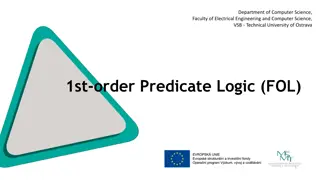Understanding Predicate Logic in Discrete Mathematics
Explore the concepts of predicates, truth values, quantified statements, and DeMorgan's law in discrete mathematics. Learn how to define, evaluate, and apply predicates using tables, functions, and truth sets. Dive into universal and existential statements, counterexamples, and witness-based arguments to enhance your understanding of predicate logic.
Download Presentation

Please find below an Image/Link to download the presentation.
The content on the website is provided AS IS for your information and personal use only. It may not be sold, licensed, or shared on other websites without obtaining consent from the author. Download presentation by click this link. If you encounter any issues during the download, it is possible that the publisher has removed the file from their server.
E N D
Presentation Transcript
CSE 20 DISCRETE MATH Fall 2020 http://cseweb.ucsd.edu/classes/fa20/cse20-a/
Today's learning goals Define a predicate over a finite domain using a table of values and as properties Determine the truth value of the proposition resulting from evaluating a predicate Describe the set of domain elements that make a predicate with one input evaluate to true. Evaluate universal and existential statements about finite domains (with no quantifier alternations). Counterexample and witness-based arguments for predicates with infinite domains Practice combinations of , in conjunction with universal and existential quantifiers State and apply DeMorgan s law for quantified statements.
Predicates as tables A predicate is a function from a given set (domain) to {T,F} It can be specified by its input-output definition table. It can be applied, or evaluated at, an element of the domain. Domain is P(001) is
Predicates as functions A predicate is a function from a given set (domain) to {T,F} It can be specified by its input-output definition table or by specifying the rule It can be applied, or evaluated at, an element of the domain.
Predicates as functions Which of the following is a description of the rule that corresponds to the input-output definition table for Mystery(x) ? A: [x]2c,3 is a non-zero number B: [x]2c,3 is a non-negative number C: [x]2c,3is a number that is even and positive D: [x]2c,3 is a number that is not positive and is not negative E: None of the above
Predicates as functions A predicate is a function from a given set (domain) to {T,F} It can be specified by its input-output definition table or by specifying the rule or by specifying its truth set: the elements of the domain at which the predicate evaluates to T Truth set for P(x) is Truth set for N(x) is Truth set for Mystery(x) is Why is specifying the truth set of a predicate enough to define its rule?
Quantified statements Rosen p. 40-45 We can make claims about a set by saying which or how many of its elements satisfy a property. These claims are called quantified statements and use predicates.
Which of the following is a true statement? A. B. C. D. All of the above E. None of the above What about the existential quantification of each of these predicates?
Counterexamples and Witnesses For a predicate E(x), which of the following is a valid proof strategy: A: We can prove that B: We can prove that C: We can prove that D: We can prove that E: More than one of the above is true using a witness. is true using a counterexample. is false using a witness. is false using a counterexample
Counterexamples and Witnesses Which of these is true? A: B: C: D: More than one of the above E: None of the above
Quantifier De Morgan Rosen p. 45
A true universal quantification is: A false universal quantification is: A true existential quantification is: A false existential quantification is:
For next time Read website carefully http://cseweb.ucsd.edu/classes/fa20/cse20-a/ Next pre-class reading: Section 2.1 Definitions 8 and 9 (p. 123). Section 1.5 Example 1 (p. 57) and Example 4 (p. 59)























